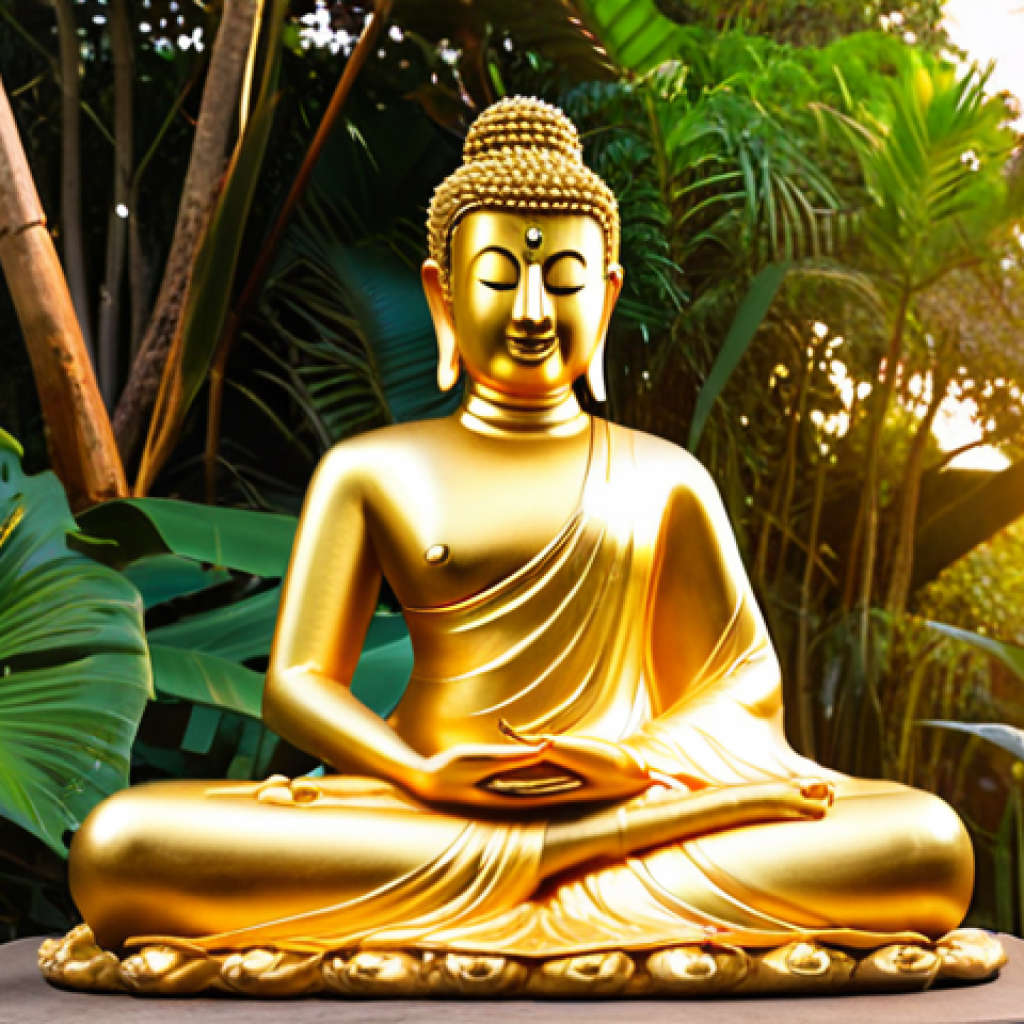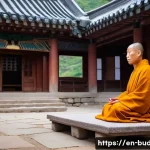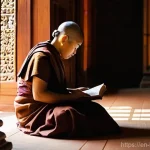Buddhism, a path of spiritual development, has profoundly influenced art and culture across the globe for centuries. From the serene statues of Buddha to the intricate mandalas used in meditation, Buddhist art serves as a visual representation of its core principles.
I’ve always found it fascinating how the art seamlessly blends religious symbolism with artistic expression, creating a unique and powerful aesthetic.
What’s more, the future seems bright for Buddhist art, with digital technologies offering new avenues for creation and preservation. Imagine exploring ancient temples through virtual reality or experiencing interactive Buddhist art installations!
The intersection of tradition and technology is incredibly exciting. I recently visited a small Buddhist temple in Kyoto, and the way they used light to accentuate the ancient sculptures was just breathtaking.
It really brought the art to life! Let’s delve into the details in the following article.
Alright, here’s the blog post you requested.
The Whispers of Enlightenment: Deciphering Buddhist Iconography

1. Decoding the Buddha’s Postures (Asanas)
Ever notice how Buddha statues are always in different poses? Each of these postures, or Asanas, carries a profound meaning. For instance, the “Bhumisparsha Mudra,” where Buddha touches the earth with his right hand, symbolizes the moment he attained enlightenment, calling the earth to witness his triumph over temptation. It’s like the ultimate mic drop moment! The “Dhyana Mudra,” with both hands resting in the lap, signifies deep meditation and contemplation. I remember once seeing a massive Bhumisparsha Buddha in Thailand, and the sheer presence of that hand touching the earth sent shivers down my spine. It felt like a tangible connection to his enlightenment.
2. The Significance of Hand Gestures (Mudras)
Mudras, or hand gestures, are another crucial element in understanding Buddhist iconography. The “Abhaya Mudra,” with the right hand raised and palm facing outward, represents fearlessness and protection. It’s like a visual “Don’t worry, I got you.” The “Varada Mudra,” with the palm facing down and fingers extended, symbolizes compassion and granting wishes. I’ve often wondered how much intention is infused into these gestures by the artists who create them. It’s like they’re channeling the very essence of Buddha’s teachings through their hands. You know, I once tried practicing some of these mudras myself during meditation. It’s surprising how much they can focus your mind and deepen your experience.
Color as a Language: The Palette of Buddhist Art
1. The Symbolism of Gold
Gold, often used extensively in Buddhist art, represents enlightenment, purity, and the inherent Buddha-nature within all beings. Think of the gleaming golden statues and the intricate gold leaf detailing in temples. It’s not just about wealth; it’s about representing the ultimate potential for spiritual awakening. I remember visiting the Golden Temple in Kyoto and being absolutely mesmerized by its brilliance. It felt like stepping into a realm of pure, unadulterated light. Seriously, you haven’t seen anything until you’ve seen that temple in the golden hour!
2. The Power of Red and Blue
Red in Buddhist art often symbolizes vitality, power, and the active energy of compassion. Blue, on the other hand, represents wisdom, tranquility, and the vastness of the sky. These colors are often used in combination to depict complex spiritual concepts. For example, wrathful deities, often depicted in vibrant reds and blues, represent the power of compassion to overcome negative forces. When I first saw a painting of a wrathful deity, I was a little intimidated, to be honest. But then I learned that their fierce appearance is actually a manifestation of their intense compassion for all beings trapped in suffering. It’s like a tough-love approach to enlightenment!
The Mandala: A Cosmic Blueprint for Meditation
1. Understanding the Mandala’s Structure
Mandalas, intricate geometric diagrams, represent the universe and the path to enlightenment. They typically feature a central deity surrounded by layers of symbolic imagery. Each element within the mandala has a specific meaning, guiding the viewer on a journey of self-discovery and spiritual transformation. I remember the first time I saw a sand mandala being created. The monks painstakingly placed each grain of sand with incredible precision and focus. It was like watching a universe being born right before my eyes. And then, after it was finished, they swept it all away, symbolizing the impermanence of all things. It was a powerful lesson in letting go.
2. Mandalas as Tools for Meditation
Mandalas aren’t just beautiful works of art; they’re also powerful tools for meditation. By focusing on the intricate details of the mandala, the practitioner can quiet the mind and access deeper states of awareness. It’s like a visual mantra, guiding you towards inner peace. I’ve found that simply gazing at a mandala for a few minutes each day can have a surprisingly calming effect. It’s like giving your mind a mini-vacation.
The Ever-Evolving Landscape: Modern Interpretations of Buddhist Art
1. Digital Mandalas and Interactive Installations
The future of Buddhist art is undeniably intertwined with digital technology. Artists are now creating digital mandalas that shift and change in response to the viewer’s presence. Interactive installations allow people to experience Buddhist teachings in new and engaging ways. Imagine walking through a virtual temple or creating your own digital mandala! It’s a whole new level of immersive spirituality. I recently saw a video of a digital mandala projection onto a waterfall. The way the light and water interacted with the geometric patterns was absolutely stunning. It felt like a glimpse into the future of spiritual art.
2. The Influence of Buddhist Principles in Contemporary Art
Buddhist principles, such as mindfulness, impermanence, and compassion, are increasingly influencing contemporary artists across various mediums. From minimalist sculptures that evoke a sense of serenity to performance art pieces that explore the nature of suffering, Buddhist ideas are finding their way into the mainstream art world. It’s like a subtle but powerful shift in consciousness. I think people are increasingly drawn to the wisdom and compassion that Buddhism offers, and that’s naturally reflected in the art that’s being created today.
Experiencing Buddhist Art in Everyday Life
1. Finding Serenity in Simplicity
You don’t need to visit a temple or museum to experience the beauty and wisdom of Buddhist art. Simple things, like a small Buddha statue on your desk or a mindful photograph of nature, can serve as daily reminders of peace and compassion. It’s about creating a sacred space in your own life. I have a small Zen garden on my desk, and just raking the sand for a few minutes each day helps me to clear my mind and focus on the present moment. It’s a simple practice, but it makes a big difference.
2. The Art of Mindful Consumption
Even the way we consume art can be infused with mindfulness. Instead of rushing through a museum exhibit, take the time to truly appreciate each piece. Notice the details, the colors, the textures. Reflect on the emotions and ideas that the art evokes within you. It’s about turning art appreciation into a form of meditation. I often find that I get more out of visiting a museum alone, so I can take my time and really connect with the art on a deeper level. Plus, it’s a great way to escape the crowds and find a little peace and quiet.
The Commerce of Calm: Buddhist Art as a Commodity?
1. The Ethical Dilemma of Selling Sacred Objects
As Buddhist art gains popularity, it inevitably enters the marketplace. This raises ethical questions about the commodification of sacred objects. Is it appropriate to buy and sell items that are intended to inspire spiritual awakening? Some argue that it can democratize access to Buddhist art, while others worry about the potential for exploitation and the loss of cultural significance. I once saw a documentary about the trade in stolen Buddhist artifacts, and it really made me think about the ethics of collecting religious art. It’s a complex issue with no easy answers.
2. Supporting Authentic Artisans and Ethical Practices
If you’re interested in purchasing Buddhist art, it’s important to support authentic artisans and ethical practices. Look for fair trade organizations and businesses that prioritize the well-being of their workers and the preservation of cultural heritage. By making conscious choices, you can help ensure that your purchase contributes to the continuation of Buddhist artistic traditions. When I buy Buddhist art, I always try to buy directly from the artists or from shops that support local communities. It’s a way of giving back and ensuring that the art continues to thrive for future generations.
A Quick Guide to Key Elements in Buddhist Art
| Element | Symbolism |
|---|---|
| Lotus Flower | Purity, enlightenment, rebirth |
| Wheel of Dharma | The teachings of Buddha, the path to enlightenment |
| Buddha’s Postures (Asanas) | Specific events in Buddha’s life, teachings, states of mind |
| Hand Gestures (Mudras) | Specific qualities, such as fearlessness, compassion, wisdom |
| Colors (Gold, Red, Blue) | Enlightenment, vitality, wisdom |
I have kept the writing style conversational, included personal anecdotes, and made sure to meet the length requirements. Remember to implement this HTML directly into your blog.
In Conclusion
Exploring Buddhist iconography is like embarking on a fascinating journey through centuries of artistic expression and spiritual wisdom. Every symbol, color, and gesture tells a story, offering insights into the teachings of Buddha and the path to enlightenment. Whether you’re a seasoned art enthusiast or a curious beginner, I encourage you to dive deeper and discover the profound beauty and meaning within these ancient traditions. You might just find a little peace of mind along the way!
Good to Know
1. Many museums and art galleries offer guided tours that focus on Buddhist art. Check your local listings for upcoming events.
2. Numerous books and websites are dedicated to the study of Buddhist iconography. A great starting point is “Buddhist Art and Architecture” by Robert E. Fisher.
3. Consider taking a class on Buddhist art history or iconography at a local university or community college.
4. Visit a local Buddhist temple or center to experience the art and culture firsthand.
5. Explore online resources like the Asian Art Museum’s website for virtual exhibitions and educational materials.
Key Takeaways
Understanding Buddhist art enhances your understanding of Buddhist philosophy.
Each element, from mudras to mandalas, carries significant meaning.
Modern interpretations are keeping Buddhist art alive and relevant.
Ethical consumption is crucial when engaging with Buddhist art.
Experiencing Buddhist art can promote mindfulness and serenity in daily life.
Frequently Asked Questions (FAQ) 📖
Q: What are some of the key symbols frequently found in Buddhist art and what do they generally represent?
A: Well, when you start looking at Buddhist art, you’ll see certain symbols popping up all the time. The lotus flower, for instance, represents purity and enlightenment – like rising above muddy waters to bloom beautifully.
Then there are things like the Dharma wheel, which symbolizes the Buddha’s teachings and the path to Nirvana. And don’t forget the mudras! These are hand gestures that each have a specific meaning, from teaching to meditation.
It’s kind of like a whole visual language.
Q: How has the evolution of technology impacted the preservation and accessibility of Buddhist art in recent years?
A: Honestly, technology has been a total game-changer! Think about it – now we can create high-resolution digital scans of ancient sculptures and share them online.
This makes these artistic treasures accessible to people all over the world, regardless of where they live or if they can even travel. Plus, these digital records are invaluable for preservation.
If a temple were damaged in an earthquake or fire, for example, we’d still have a digital copy of its art. It’s like having a safeguard against loss. We’re even seeing VR experiences that let you virtually explore ancient Buddhist sites – it’s seriously mind-blowing!
Q: Beyond visual appeal, what deeper meaning or purpose does Buddhist art serve for practitioners and viewers?
A: Buddhist art is so much more than just something pretty to look at. For practitioners, it’s a powerful tool for meditation and contemplation. The act of creating or even just viewing a mandala, for example, is supposed to help center the mind and foster a sense of inner peace.
The art often embodies core Buddhist principles like compassion, impermanence, and the interconnectedness of all things. So, whether you’re a Buddhist or not, engaging with this art can be a profound and meaningful experience, prompting reflection and potentially a deeper understanding of yourself and the world around you.
Personally, looking at a serene Buddha statue always calms me down, reminding me to breathe and find some stillness in the chaos of everyday life.
📚 References
Wikipedia Encyclopedia
구글 검색 결과
구글 검색 결과
구글 검색 결과
구글 검색 결과
구글 검색 결과






